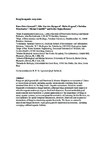Fungi in aquatic ecosystems
| dc.contributor.author | Grossart, H-P | |
| dc.contributor.author | Van den Wyngaert, S | |
| dc.contributor.author | Kagami, M | |
| dc.contributor.author | Wurzbacher, C | |
| dc.contributor.author | Cunliffe, M | |
| dc.contributor.author | Rojas-Jimenez, K | |
| dc.date.accessioned | 2022-02-08T16:10:52Z | |
| dc.date.available | 2022-02-08T16:10:52Z | |
| dc.date.issued | 2019-06 | |
| dc.identifier.issn | 1740-1526 | |
| dc.identifier.issn | 1740-1534 | |
| dc.identifier.uri | http://hdl.handle.net/10026.1/18716 | |
| dc.description.abstract |
Fungi are phylogenetically and functionally diverse ubiquitous components of almost all ecosystems on Earth, including aquatic environments stretching from high montane lakes down to the deep ocean. Aquatic ecosystems, however, remain frequently overlooked as fungal habitats, although fungi potentially hold important roles for organic matter cycling and food web dynamics. Recent methodological improvements have facilitated a greater appreciation of the importance of fungi in many aquatic systems, yet a conceptual framework is still missing. In this Review, we conceptualize the spatiotemporal dimensions, diversity, functions and organismic interactions of fungi in structuring aquatic food webs. We focus on currently unexplored fungal diversity, highlighting poorly understood ecosystems, including emerging artificial aquatic habitats. | |
| dc.format.extent | 339-354 | |
| dc.format.medium | ||
| dc.language | en | |
| dc.language.iso | eng | |
| dc.publisher | Springer Science and Business Media LLC | |
| dc.rights | Attribution-NonCommercial-NoDerivatives 4.0 International | |
| dc.rights | Attribution-NonCommercial-NoDerivatives 4.0 International | |
| dc.rights | Attribution-NonCommercial-NoDerivatives 4.0 International | |
| dc.rights.uri | http://creativecommons.org/licenses/by-nc-nd/4.0/ | |
| dc.rights.uri | http://creativecommons.org/licenses/by-nc-nd/4.0/ | |
| dc.rights.uri | http://creativecommons.org/licenses/by-nc-nd/4.0/ | |
| dc.subject | Antibiosis | |
| dc.subject | Biomass | |
| dc.subject | Ecosystem | |
| dc.subject | Food Chain | |
| dc.subject | Fungi | |
| dc.subject | Water Microbiology | |
| dc.title | Fungi in aquatic ecosystems | |
| dc.type | journal-article | |
| dc.type | Review | |
| plymouth.author-url | https://www.ncbi.nlm.nih.gov/pubmed/30872817 | |
| plymouth.issue | 6 | |
| plymouth.volume | 17 | |
| plymouth.publication-status | Published | |
| plymouth.journal | Nature Reviews Microbiology | |
| dc.identifier.doi | 10.1038/s41579-019-0175-8 | |
| plymouth.organisational-group | /Plymouth | |
| plymouth.organisational-group | /Plymouth/Faculty of Science and Engineering | |
| plymouth.organisational-group | /Plymouth/Faculty of Science and Engineering/School of Biological and Marine Sciences | |
| plymouth.organisational-group | /Plymouth/REF 2021 Researchers by UoA | |
| plymouth.organisational-group | /Plymouth/REF 2021 Researchers by UoA/UoA07 Earth Systems and Environmental Sciences | |
| plymouth.organisational-group | /Plymouth/Users by role | |
| plymouth.organisational-group | /Plymouth/Users by role/Academics | |
| dc.publisher.place | England | |
| dc.identifier.eissn | 1740-1534 | |
| dc.rights.embargoperiod | Not known | |
| rioxxterms.versionofrecord | 10.1038/s41579-019-0175-8 | |
| rioxxterms.licenseref.uri | http://creativecommons.org/licenses/by-nc-nd/4.0/ | |
| rioxxterms.type | Journal Article/Review |



